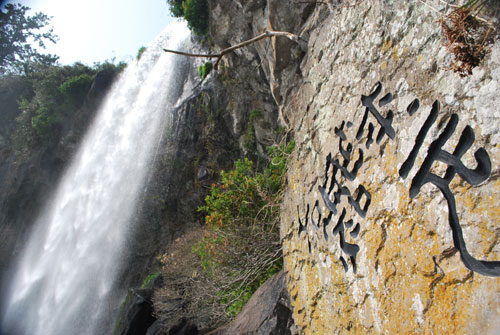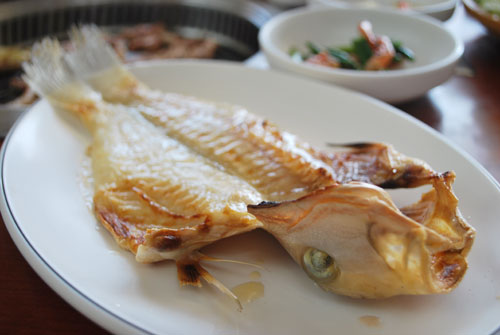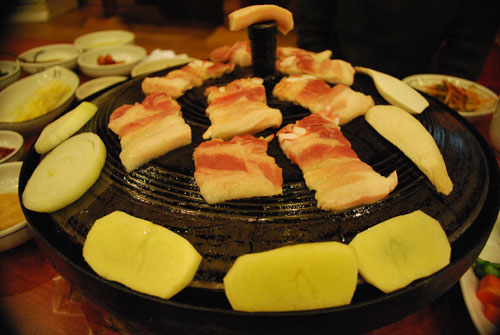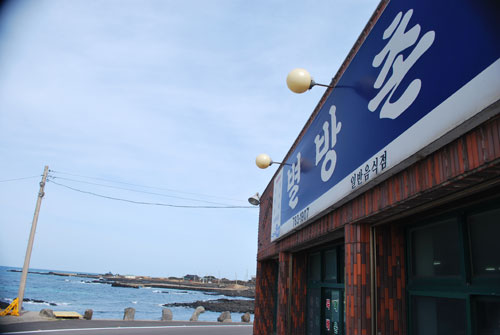 Open for business! Sliced abalone served next to Jeongbang Waterfall, thanks to a local haenyeo (woman diver).
Open for business! Sliced abalone served next to Jeongbang Waterfall, thanks to a local haenyeo (woman diver).
Over the past few weeks, we saw Jeju’s fire festival and climbed South Korea’s highest peak. But now, it’s time to eat!
As a huge volcanic island, it makes sense that there’s a dearth of arable land on Jeju. But being an island also means that seafood has always been a staple of Jejanese cuisine. So to start our culinary exploration, let’s start at the beach… but one warning, food on Jeju doesn’t come cheap!
 2,000-year-old graffiti. Legend says that an emissary of a Chin Dynasty emperor came here in search of an elixir for eternal life. He didn’t find it, but carved his name before returning to China.
2,000-year-old graffiti. Legend says that an emissary of a Chin Dynasty emperor came here in search of an elixir for eternal life. He didn’t find it, but carved his name before returning to China.
Among Jeju’s most famous residents are its haenyeo (해녀), or women sea divers. Although sea diving is an ancient custom on Jeju, it wasn’t until 1629 that women dove en masse. Some say the change was to avoid paying taxes, or maybe just a clever ploy to get women to do the hard work. Either way, centuries later, Jejanese women still dive up to 20 meters to harvest seaweed and shellfish, amazingly without the aid of breathing devices.
 Delicious, no frills cuisine, Jeju-style.
Delicious, no frills cuisine, Jeju-style.
Sadly, the practice is in decline. Today just a few thousand of Jeju’s mermaid grannies still reap the sea’s bounty. But lucky for me and my friend Uikwon, we ran into three of them just feet from the surf near Jeongbang Waterfall (정방폭포). Their simple operation centered around three orange tubs filled with sea cucumbers, snails and abalone. For a pricey 10,000 won ($6.60), a medium-sized abalone was sliced into eight slices and served to us no frills alongside small dishes of hot pepper paste and a garlic slices.
 We enjoyed delicious tilefish at the Songjeongmehyang Restaurant, located near the Jeongbang Waterfall in Seogwipo.
We enjoyed delicious tilefish at the Songjeongmehyang Restaurant, located near the Jeongbang Waterfall in Seogwipo.
An hour later it was almost lunchtime. So while purchasing a bag of Jeju’s famous tangerines (a bargain at just 3,000 won for 8), we asked for recommendations for a tasty neighborhood spot. A short walk later we saw a row of beachside restaurants. It was both early in the season and early in the day, which must have been why we were the only customers at Ms. Lee’s Songjeongmehyang (송정미향) Restaurant, especially since their roasted tilefish (옥돔구이) was delicious. Caught only in Jeju and in the waters off Japan, the rich, baked white fish separated easily from the bone and mixed nicely with several vegetable side dishes.
 The Sigol Restaurant in Pyoseon serves up excellent ogyeopsal, a five-layered barbeque pork.
The Sigol Restaurant in Pyoseon serves up excellent ogyeopsal, a five-layered barbeque pork.
Appetite satiated, we were back on the road. After several hours of exploring Jeju’s southern coast, we arrived in Pyoseon (표선), a hamlet that hugs a tiny bay on Jeju’s southeast shoreline. Not coincidentally, Uikwon’s family has a favorite local barbeque place there, so we stopped into the Countryside Restaurant (시골식당) for dinner. The establishment serves an excellent ogyeopsal, or five-layered pork. Made from Jeju’s famous black pig, 200 grams was 11,000 won ($7.27). Relaxing on the floor we watched the thick bacon-like meat sizzle in front of us before devouring it!
 The seaside Byeolbangchon Restaurant serves fresh and delicious raw fish, called hwae.
The seaside Byeolbangchon Restaurant serves fresh and delicious raw fish, called hwae.
The next morning we had time for one more meal before leaving Jeju. Since our culinary tour started with the haenyeo it seemed right that we end there, too. The northeastern town of Sewha hosts the Jeju Haenyeo Museum (제주해녀박물관), so we asked the ticket seller there where we could find some good raw fish, or hwae (회). He pointed us up the road, where Byeolbangchon (별방촌) sits alone beside the black rocky beach.
 Our last meal in Jeju was a large platter of sliced, raw flounder.
Our last meal in Jeju was a large platter of sliced, raw flounder.
For 50,000 won (about $33), we ordered a whole raw flounder (광어). While Ms. Song prepared the fish, we sampled side dishes of raw sea cucumber, clams, snails, and a crispy vegetable pancake. Minutes later, a large platter covered in thin slices of raw fish arrived. The silver-white flesh shimmered in the light and melted in our mouths. It was a delicious end to our Jeju food tour.
Getting There:
→ From Seoul’s Gimpo International Airport, dozens of flights depart for Jeju City daily.
The 1-hour flight costs between 167,000-244,000 won ($113-$165) on major Korean carriers, and around 108,000 won ($73) on budget carriers, like Jeju Air.
Once on Jeju, reach the Jeongbang Waterfall by taking road 1131 towards Seogwipo. Turn left on 1132. From the waterfall, you can retrace our food tour route by following road 1132 to Pyoseon and Sewha. The scenic route hugs the coastline.
Byeolbangchon (별방촌): (064) 783-1907
Jeju Haenyeo Museum (제주해녀박물관): (064) 741-0374~5
Songjeongmehyang Restaurant (송정미향): (064) 763-5775~6
Learn More:
→ Jeju Special Self-Governing Province (official site)
(A version of this text aired on KBS World Radio on March 7, 2009.)



mm..the sushi looks so fresh!
I think I have to go Jeju this month,
I’m expecting next part!
By: Narsha Lee on 5 March 2009
at 00:32
Hi again, Narsha!
The raw rish in Sewha was delicious! If you go to Jeju again this month, let me know!
Matt
By: Matt Kelley on 5 March 2009
at 12:18
wooow yeah it looks yummooo.. hi i’m matt from Indonesia and next week i would visit jeju to fulfill invitation to perform in Jeju International Choir Festival.. I hope i could also taste that yummoo sushi :) Btw do you have any recommendation ‘a must see’ place or ‘a must taste’ food and what souvenir that could specifically describing Jeju?
By: matt danalan on 10 July 2009
at 12:06
Hi Matt,
Lucky you! I think the international choir festival sounds like a lot of fun. In terms of food, Jeju is most famous for its seafood (no big surprise), its local tangerines and its black pig. I know a lot of Indonesians don’t eat pork, so maybe you’ll have to stick to the raw rish (hwae) and grilled eel.
The quintessential Jeju souvenir is probably a tiny granfather statue carved in black lava rock. These curious figures are said to inspire fertility and are one of the main symbols of the island.
Finally, in terms of “must-see” places, it’s so hard to make suggestions to this popular question since I’m not sure what you like… but my favorite part about Jeju is just the peaceful fields interrupted by the parasitic volcanoes that pop up everywhere. Climbing to the top and enjoying the scenery is really special. Otherwise, check out the Haenyeo Museum for the women free divers, there’s also an emotional museum remembering the persecution of Jeju’s people during the communist scares in past decades (I think it’s called the 5/13 museum?) and a lot of people like walking along the Jungmun Beach area with the fancy hotels on the southwest coast. I hope that’s a good start for you. Have a wonderful time!
Best, Matt
By: Matt Kelley on 11 July 2009
at 00:46
Hi Matt – what a wonderful blog! I’m going to Korea for the first time in October, and we will be going to Seoul and Jeju. I plan on checking out the food places you have mentioned here. I’ve never had fresh (or even canned!) abalone, and I hope to find those women! All the other foods you mentioned and took pictures of look good as well. This blog one of the best resources I’ve come across for info on visiting Korea!
When do you expect that your book will be published?
~Sophia
By: SOPHIA on 25 August 2009
at 04:17
Hi Sophia,
Your comments are very kind, thank you. October is perhaps the best time to visit, so lucky you! The haenyo (women divers) aren’t easy to find these days, but keep an eye out. RE: the book, I expect to have a Seoul-focused travel book at the end of the year. I may also publish a photo-book about Korea before year’s end, too, just waiting to gauge interest.
Thanks again, and have a great time in Korea! ~Matt
By: Matt Kelley on 1 September 2009
at 06:03